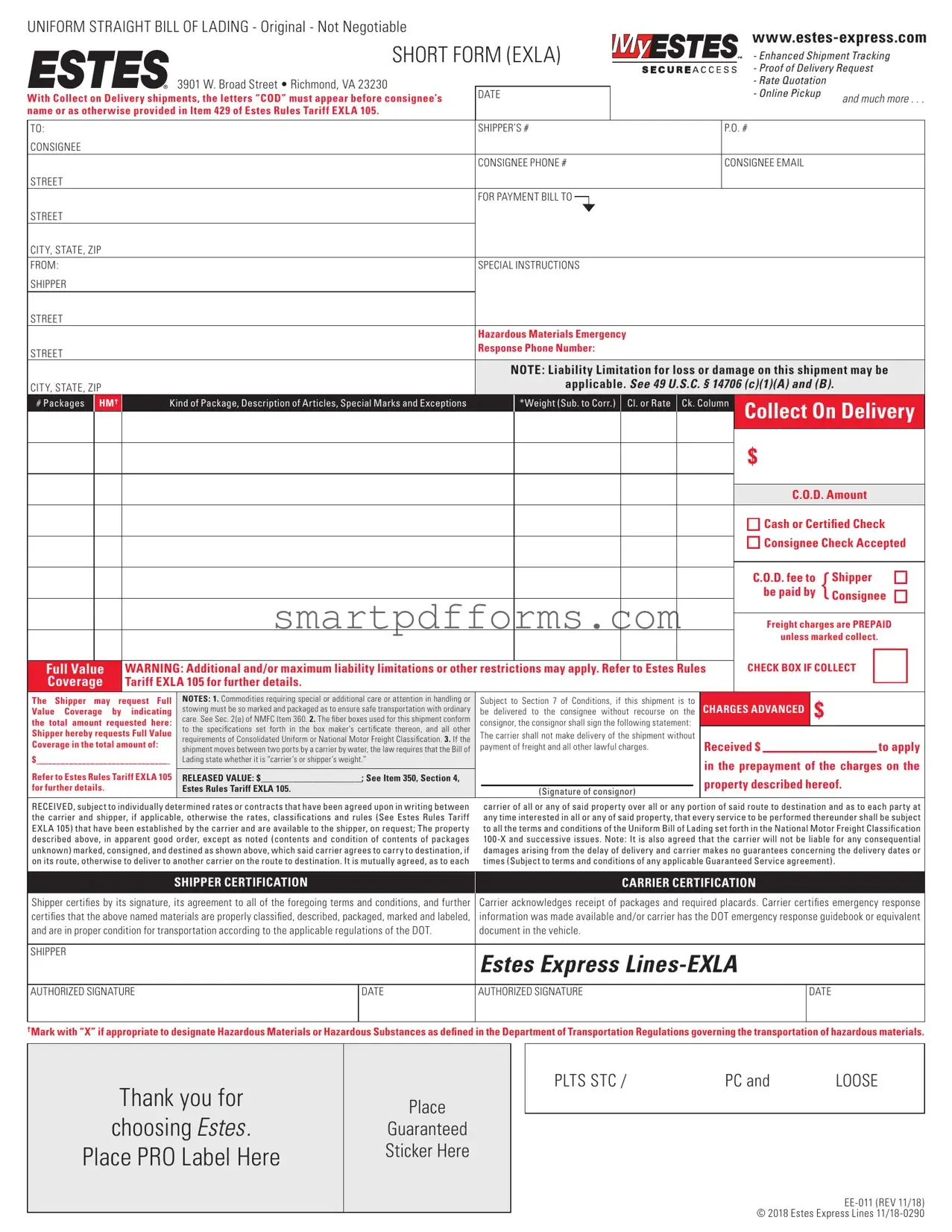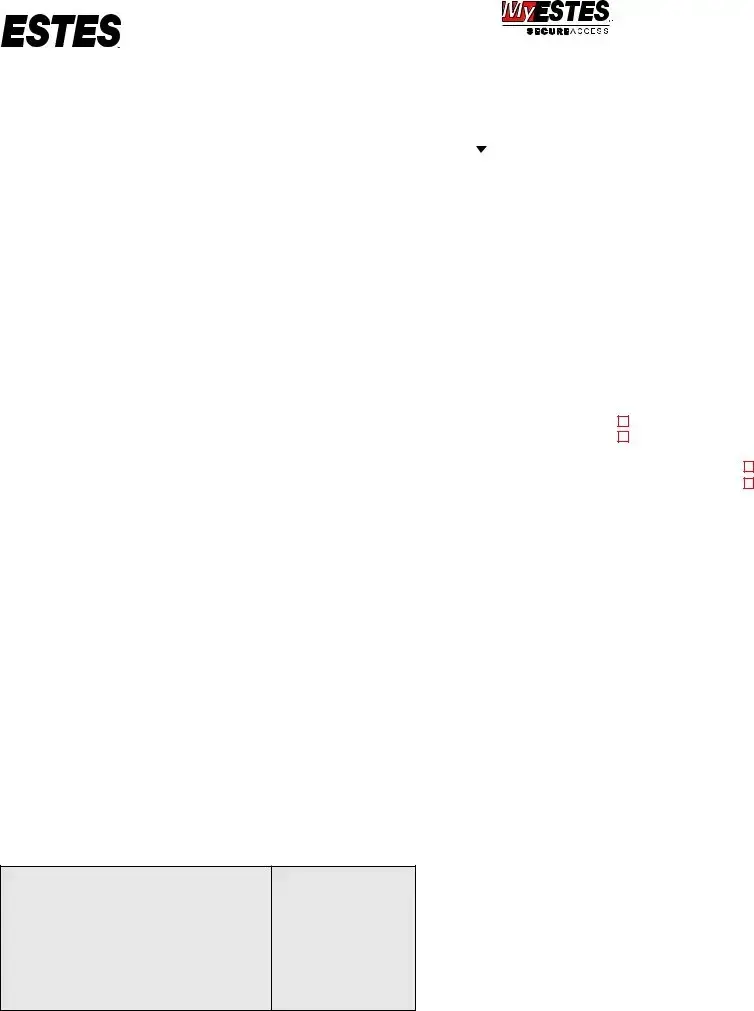TO: |
|
|
|
|
SHIPPER’S # |
|
|
|
P.O. # |
|
|
|
|
CONSIGNEE |
|
|
|
|
|
|
|
|
|
|
|
|
|
|
|
|
|
|
|
|
|
|
|
|
|
|
|
|
|
CoNSIGNEE PhONE # |
|
|
|
CoNSIGNEE EmAIL |
|
|
|
|
STREET |
|
|
|
|
|
|
|
|
|
|
|
|
|
|
|
|
|
|
|
|
|
|
|
STREET |
|
|
|
|
FOR PAYMENT BILL TO |
|
|
|
|
|
|
|
|
|
|
|
|
|
|
|
|
|
|
|
|
|
|
|
|
|
|
|
|
|
|
|
|
|
|
|
|
|
|
|
|
|
|
|
|
|
|
|
|
|
|
|
|
|
|
|
|
|
|
|
CITY, STATE, ZIP |
|
|
|
|
|
|
|
|
|
|
|
|
|
|
|
|
|
|
|
|
|
|
|
FROM: |
|
|
|
|
SPECIAL INSTRUCTIONS |
|
|
|
|
|
|
|
|
|
|
|
|
SHIPPER |
|
|
|
|
|
|
|
|
|
|
|
|
|
|
|
|
|
|
|
|
|
|
|
STREET |
|
|
|
|
|
|
|
|
|
|
|
|
|
|
|
|
|
|
|
|
|
|
|
|
|
|
|
|
|
Hazardous Materials Emergency |
|
|
|
|
|
|
|
|
|
|
|
|
STREET |
|
|
|
|
Response Phone Number: |
|
|
|
|
|
|
|
|
|
|
|
|
|
|
|
|
|
|
|
|
|
|
|
|
|
|
|
|
|
|
|
|
|
|
|
|
|
|
|
|
|
|
NOTE: Liability Limitation for loss or damage on this shipment may be |
CITY, STATE, ZIP |
|
|
|
|
|
|
applicable. See 49 U.S.C. § 14706 (c)(1)(A) and (B). |
# Packages |
HM† |
Kind of Package, Description of Articles, Special Marks and Exceptions |
|
|
*Weight (Sub. to Corr.) |
Cl. or Rate |
|
Ck. Column |
|
Collect On Delivery |
|
|
|
|
|
|
|
|
|
|
|
|
|
|
|
|
|
|
|
|
|
|
|
|
|
|
|
|
|
|
|
|
|
|
|
|
$ |
|
|
|
|
|
|
|
|
|
|
|
|
|
|
|
|
|
|
|
|
|
|
|
|
|
|
|
|
|
|
|
|
|
|
|
|
|
|
|
|
|
|
|
|
|
|
|
|
|
|
|
|
|
|
|
|
|
|
|
|
|
|
|
|
|
|
|
|
|
|
|
|
|
|
|
|
|
|
|
|
|
|
|
|
|
|
|
|
|
|
|
|
|
|
|
|
|
|
C.O.D. Amount |
|
|
|
|
|
|
|
|
|
|
|
|
|
|
|
|
|
|
|
Cash or Certified Check |
|
|
|
|
|
|
|
|
|
|
|
|
|
|
|
|
|
|
|
Consignee Check Accepted |
|
|
|
|
|
|
|
|
|
|
|
|
|
|
|
|
|
|
|
|
|
|
|
|
|
|
|
|
|
|
|
|
|
|
|
|
|
|
|
|
|
|
|
|
|
|
|
|
|
|
|
|
|
|
|
|
|
|
C.O.D. fee to |
Shipper |
|
|
|
|
|
|
|
|
|
|
|
|
|
|
|
|
|
|
|
|
|
|
|
|
|
|
|
|
|
|
|
|
|
|
|
|
|
be paid by |
{Consignee |
|
|
|
|
|
|
|
|
|
|
|
|
|
|
|
|
|
|
|
|
|
|
|
|
|
|
|
|
|
|
|
|
|
|
|
|
|
|
Freight charges are PREPAID |
|
|
|
|
|
|
|
|
|
|
|
|
|
|
|
|
|
|
|
unless marked collect. |
|
|
|
|
|
|
|
|
|
|
|
|
|
|
|
|
|
|
|
|
|
|
|
|
|
|
|
|
|
|
|
|
|
|
|
|
|
|
|
|
|
|
|
|
|
|
|
Full Value |
WARNING: Additional and/or maximum liability limitations or other restrictions may apply. Refer to Estes Rules |
|
CHECK BOX IF COLLECT |
|
|
|
Coverage |
Tariff EXLA 105 for further details. |
|
|
|
|
|
|
|
|
|
|
|
|
|
|
|
|
|
|
|
|
|
|
|
|
|
|
|
|
|
|
|
|
|
|
|
|
|
|
|
|
|
|
NOTES: 1. Commodities requiring special or additional care or attention in handling or |
|
|
|
|
|
|
|
|
|
|
|
|
|
|
|
|
|
|
The Shipper may request Full |
|
Subject to Section 7 of Conditions, if this shipment is to |
CHARGES ADVANCED |
$ |
|
|
|
Value Coverage by |
indicating |
|
care. See Sec. 2(e) of NMFC Item 360. 2. The fiber boxes used for this shipment conform |
be delivered to the consignee without recourse on |
the |
|
|
|
|
|
|
|
stowing must be so marked and packaged as to ensure safe transportation with ordinary |
|
|
|
|
|
|
|
|
|
|
|
|
|
|
|
|
|
|
|
the total amount requested here: |
|
to the specifications set forth in the box maker’s certificate thereon, and all other |
consignor, the consignor shall sign the following statement: |
|
|
|
|
|
|
|
|
|
|
Shipper hereby requests Full Value |
|
The carrier shall not make delivery of the shipment without |
|
|
|
|
|
|
|
|
|
|
|
requirements of Consolidated Uniform or National Motor Freight Classification. 3. If the |
|
|
|
|
|
|
|
|
|
Coverage in the total amount of: |
|
payment of freight and all other lawful charges. |
|
|
Received $ |
|
|
|
|
to apply |
|
shipment moves between two ports by a carrier by water, the law requires that the Bill of |
|
|
|
|
|
|
$_______________________________ |
|
|
|
|
|
|
|
|
|
|
|
|
|
|
|
Lading state whether it is “carrier’s or shipper’s weight.” |
|
|
|
|
|
|
|
|
|
in the prepayment of the charges on the |
Refer to Estes Rules Tariff EXLA 105 |
RELEASED VALUE: $________________________; See Item 350, Section 4, |
|
|
|
|
|
|
|
|
|
|
|
|
|
|
|
|
|
|
property described hereof. |
for further details. |
|
|
Estes Rules Tariff EXLA 105. |
|
|
|
|
|
|
|
|
|
|
|
|
|
(Signature of consignor) |
|
|
RECEIVED, subject to individually determined rates or contracts that have been agreed upon in writing between |
|
carrier of all or any of said property over all or any portion of said route to destination and as to each party at |
the carrier and shipper, if applicable, otherwise the rates, classifications and rules (See Estes Rules Tariff |
|
any time interested in all or any of said property, that every service to be performed thereunder shall be subject |
EXLA 105) that have been established by the carrier and are available to the shipper, on request; The property |
|
to all the terms and conditions of the Uniform Bill of Lading set forth in the National Motor Freight Classification |
described above, in apparent good order, except as noted (contents and condition of contents of packages |
|
100-X and successive issues. Note: It is also agreed that the carrier will not be liable for any consequential |
unknown) marked, consigned, and destined as shown above, which said carrier agrees to carry to destination, if |
|
damages arising from the delay of delivery and carrier makes no guarantees concerning the delivery dates or |
on its route, otherwise to deliver to another carrier on the route to destination. It is mutually agreed, as to each |
|
times (Subject to terms and conditions of any applicable Guaranteed Service agreement). |
|
|
|
|
|
|
|
|
|
|
|
|
|
|
|
|
|
|
|
|
|
|
|
|
|
|
SHIPPER CERTIFICATION |
|
|
|
|
|
CARRIER CERTIFICATION |
|
|
|
|
Shipper certifies by its signature, its agreement to all of the foregoing terms and conditions, and further |
Carrier acknowledges receipt of packages and required placards. Carrier certifies emergency response |
certifies that the above named materials are properly classified, described, packaged, marked and labeled, |
information was made available and/or carrier has the DOT emergency response guidebook or equivalent |
and are in proper condition for transportation according to the applicable regulations of the DOT. |
document in the vehicle. |
|
|
|
|
|
|
|
|
|
|
|
|
|
|
|
|
|
|
|
|
|
|
|
|
|
|
|
|
|
|
|
|
|
|
|
|
|
SHIPPER |
|
|
|
|
Estes Express Lines-EXLA |
|
|
|
|
|
|
|
|
|
|
|
|
|
|
|
|
|
|
|
|
|
|
|
|
|
|
|
|
|
|
|
|
|
|
|
|
|
|
|
|
AUTHORIZED SIGNATURE |
|
|
DATE |
AUTHORIZED SIGNATURE |
|
|
|
|
|
|
|
DATE |
|
|
|
|
|
|
|
|
|
|
|
|
|
|
|
|
|
|
|
|
|
|
|
|
|

